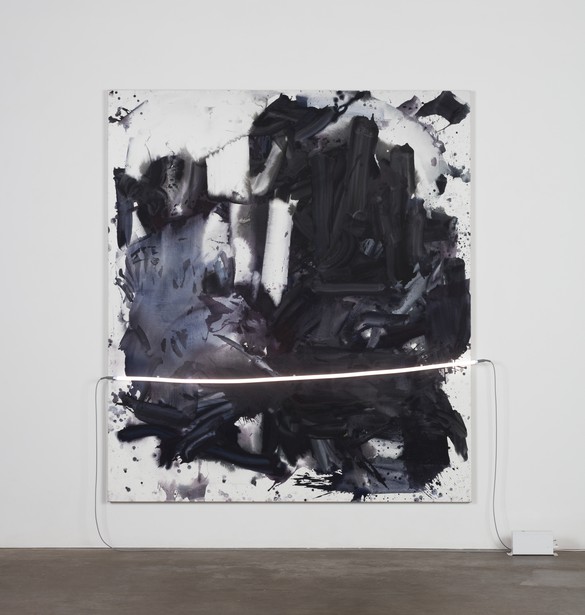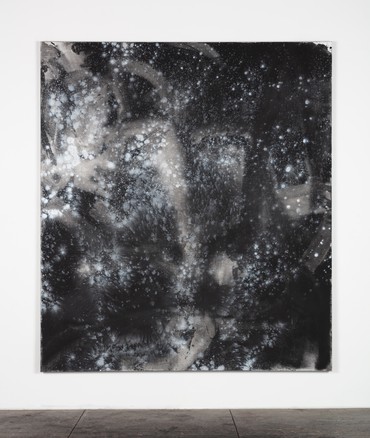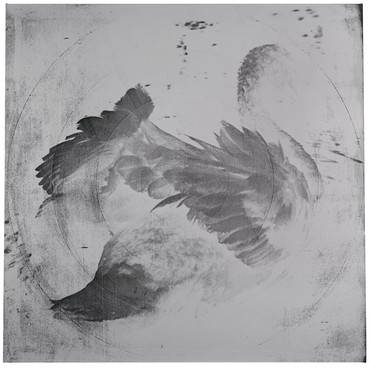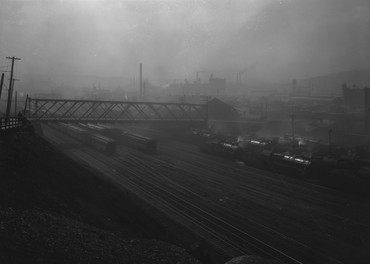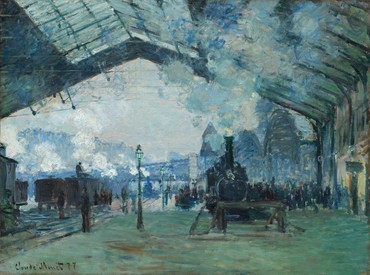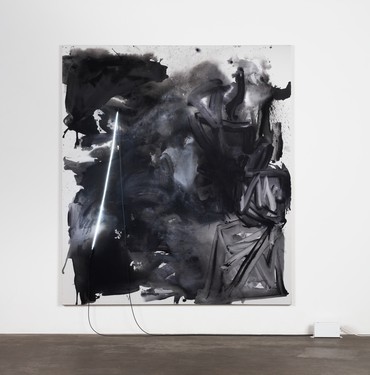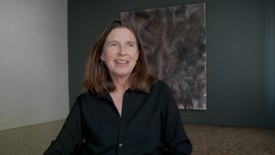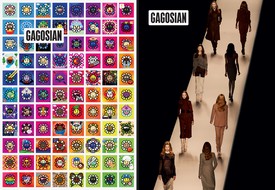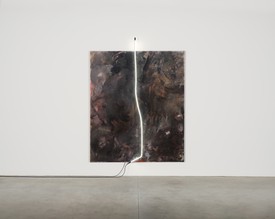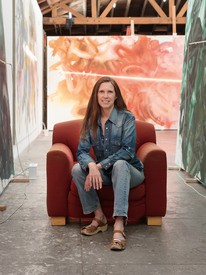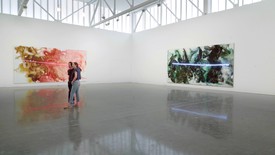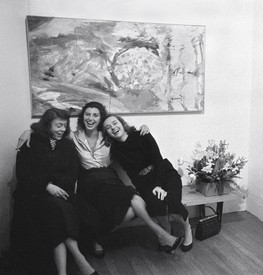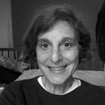
Laura Hoptman is the executive director of the Drawing Center in New York. She has been a curator of contemporary art and a leading participant in the international art conversation for three decades. She joined the Drawing Center after eight years as a curator in the Department of Painting and Sculpture at the Museum of Modern Art, New York.

Mary Weatherford’s paintings comprise grounds of spontaneously sponged paint on heavy linen canvases, surmounted by one or more carefully shaped and placed colored neon tubes. The grounds, startlingly varied in color and treatment, are redolent but not descriptive of climates, places, and situations. Photo: Antony Hoffman
Laura Hoptman Over the past ten years, you have concentrated on making abstract paintings, using Flashe paint and incorporating neon. During this time you have painted in series, giving each an allusive place name, like The Bakersfield Project or Coney Island. What is striking about your paintings is not only the atmospheric beauty that emanates from them, but how they conjure a narrative using the language of pure abstraction. Of course, you make this happen through lots of different techniques, including the use of Flashe. To begin, can you explain what this material is, and why you use it?
Mary Weatherford Two main reasons. I started experimenting with it back in 1988, when I was still trying to use oil paint in my apartment. Essentially, my studio was my bedroom, and I didn’t want to smell turpentine. That was a practical reason for my switch to a water-based medium. The other reason, which I think is more important, was that I didn’t want to go head-to-head with the history of oil painting. Even the scent of an oil painting signifies a historical continuum. I wanted to jump the track. I know we’re going to talk about trains!
The thing about Flashe is that it’s very matte. It resembles gouache, and it resembles fresco, a technique in which the paint sinks into the plaster. A fresco doesn’t have the richness that an oil painting does—black in a fresco is never as black as, say, the black you see in a Rembrandt, because the color soaks in. The “paint” that you use in fresco—dry pigment in water—looks like tempera, like what kids paint with at school. When I began using Flashe, it felt like I wasn’t painting with something of real value. Conceptually, that connected to the feminist imagery that I was using at the time—flowers, butterflies, and seashells. At the time that I was making these works, artists like Anselm Kiefer and Julian Schnabel were popular. Susan Rothenberg, who just passed away, was working with oil paint. She was very influential for me. But I really wanted to try painting with something that wasn’t revered; I wanted to go down another track.
LH But you also use Flashe because it’s luminous, like gouache, don’t you? And you paint on a white ground?
MW Yes. It’s a white ground that I’ve come up with, a fresco-type ground. I take regular store-bought gesso and add powdered chalk from Bologna and marble dust, which gives a bit of sparkle. Both of these additives are absorbent, so the paint doesn’t sit on top, but soaks in like watercolor on paper. My idea was that I would never use white paint, that the white of the ground would be the source of light—the painting would be lit from within.
LH So the neon, then, is light upon light, in a way.
MW Exactly.
Things are always changing, and maybe not on purpose. I kind of let the paintings change, and I can’t stop them from changing.
Mary Weatherford
LH And what it does for the viewer is to create an atmosphere. For me, it gave me a realization of how abstraction could be narrative. Because there was no doubt in my mind when I first saw your paintings—and it’s still the same—that these were landscapes.
MW I know you’ve said that for a long time and I resisted, but I’m finally caving in and admitting it.
LH Let’s talk about your new group of paintings, called the Train Yard series. How did these come about?
MW I began work on the series in 2016, so it’s four years in the making. I had the idea of a room of black paintings with white lights. The lights would indicate things that were far away from you moving closer, moving away, bells, the sounds of a train yard, a distant whistle; all went into the vision for this group of works. The exhibition is like a story, some kind of narrative. It’s not all the same train yard. It’s not all the same train. It’s largely in my imagination. Sometimes I wonder: What would it be like to be riding on top of a train and looking up at the stars? What is it like to be somewhere?
I’ve spoken before about trying to paint sound. Like, what is a painting of the sound of crickets? What is a painting of the buzz of a summer’s day or a birdsong? I’m interested in other artists who try to paint sound, like Charles Burchfield. I try to depict or deliver not only a visual translation of a place in time, but with that, the scent, the sound, and the feeling. Is it chilly? Is it hot? Is there a clanging sound? I feel a bit self-conscious about going back over the American history here, but I am interested in the laying of the transcontinental railroad and the impact of the railroad on all humans living in North America.
LH There are several innovations in the series that make it stand out from other recent bodies of work. The first is that, as you mentioned, you eschewed color; the paintings are primarily black and white. The second is that several works do not incorporate neon, which over the past decade has become a kind of signature element. And finally, the technique of putting the Flashe on the paintings is varied and a bit different.
Some of the paintings look like constellations in a night sky. How do you get that quality? Is it with paint, or is it the ground coming through?
MW Two of the most recent paintings are without neon and have spatters of silver paint. In the case of the first one, I was finished with the painting and was about to leave the studio, and I saw a bucket of silver paint and I thought, You know what? Let me try this. I stuck my hand in it, and I just flung the silver paint across the painting. I came back two days later—we have to wait until the paint dries, and then we stretch it up—and that painting was so magnificent in terms of its space and light . . . In it you can see there are headlights—you know when you’re driving and it’s snowing and the headlights light up the snow? That’s sort of what it looks like.
It’s good to have a few paintings going at the same time, because that’s how I allow myself to experiment.
I try to depict or deliver not only a visual translation of a place in time, but with that, the scent, the sound, and the feeling.
Mary Weatherford
LH I see some of the Train Yards as skyscapes. What do you think?
MW I’m caving to that idea.
LH You’ve done seascapes, too—in an earlier life the sea was enormously important to you. Maybe a better description than landscape—or skyscape or seascape—is the atmospherics of place.
MW Yes.
LH The story imbues—imbues is a good term, because that’s physically how you use your paint, too—your canvases.
MW Yeah.
LH You know the phrase “show as well as tell” in literary critique? I think this is one of the things that your paintings do. They don’t describe atmosphere; they create it. They don’t say, This a honky-tonk strip in Bakersfield, or a train yard in the United States at night. We are just there. It’s in a way a very old-fashioned notion of the painting as a window. I mean, there’s the conceptual thing going on too—one you started when you would stick a shell on top of a painting of an ocean or a sea or a beach. You’re putting the neon on your canvases so the actual light can live with the light you created. You’re a contemporary artist. There’s nothing about your pictures that would make me think that they weren’t from the second decade of the twenty-first century.
Do you see the Train Yard series sequentially? Is that how the viewer should ideally look at them?
MW No, not really. It’s been interesting to hang them in the studio and see which paintings can live next to one another. Even though they’re all black, certain paintings don’t like to be proximate to other paintings. So, it’s a matter of composing the show the way I compose a painting. That’s an interesting aspect of trying to paint an entire show—I think about it as an installation. Maybe that’s influenced by living in New York City in the 1980s and early 1990s, and seeing one installation after another. Do you remember how many there were?
LH We came of age in the moment of installations!
MW We were steeped in them. Over and over and over. I remember a Judy Pfaff installation at Holly Solomon on West Broadway. It was one of the first gallery exhibitions I ever saw. And there was a whole movement of women artists who made kind of architectural installations, like Lauren Ewing.
So with this series, I’ve always conceived of the works as being seen all at once—each painting standing on its own, but one informing the other, and in that you would get the feeling of lights moving toward you and away from you.
LH How was it not using color? It’s like tying one hand behind your back.
MW I’ve done it before. The second show I made, in 1991 in Zurich, was completely black and white. I spent a year mixing different colors of black for that show; red black, green black, blue black, black black, gray black, and different colors of white. I like draining the painting of color to concentrate on the form.
LH How did you bring the different shades of black into this project?
MW When you see the works in person, they are very different from one another. One is much more purplish; some have blue. When you’re standing in front of them, you see all the colors. Like you do when you’re looking at an Ad Reinhardt.
LH That’s a perfect analogy, actually. I’m glad that you brought up Reinhardt. You never bring up Mark Rothko, and you never bring up Clyfford Still unless I poke you.
MW Of course I love Rothko. Whenever I’m in London, I see his works at Tate Modern. I’ve seen the Rothko Chapel in Houston. There’s so much color to the paintings in Houston—I mean, they are not black paintings. They’re blue paintings, they’re red paintings, they’re purple paintings. It’s like being in a Doug Wheeler installation! It’s dark, and you wait and wait and wait, and finally you can start to make out the person next to you.
LH How do you go about titling your works? Clearly you make them first and then title them.
MW Let’s talk about titles. You probably know more than I do about this, but my example is always Marcel Duchamp and his idea that language can change what an object is doing. So if there’s a shovel hanging on the wall and it’s called Shovel, that’s one thing. But if Duchamp calls it In Advance of the Broken Arm, then it’s funny, it’s interesting. I mean, it’s delightful.
LH It’s art.
MW Like Damien Hirst’s title for his shark, which I can never remember—
LH The Physical Impossibility of Death in the Mind of Someone Living.
MW Yes. For me, the work would be ineffective without the title. It could be just a shark in formaldehyde, but it’s not.
LH I guess what you’re trying to say in a self-abnegating way is that you’re following a great tradition in making the title integral to your work. But I would argue with that, because I think that in both of the cases you just mentioned, the work doesn’t work without the title, and I’m not so sure about that with your paintings. I think they do work without their titles. Just differently.
MW I agree with you. Maybe with me, it’s romantic. I look at No. 4000 (2017–18), and I see blocks of metal maybe moving, and there’s a bit of silver paint that makes it really steamy. To me, this painting references the steam engine. Now, am I going to call the painting The Steam Engine? I think that’s a little bit too obvious. I need a bit more poetry. I didn’t put the steamy effect in all of the paintings, but for me, this one has the art historical reference of that great Monet painting of the train pulling into the station and the steam just billowing up, filling the glass-ceilinged station in Paris, filling the canvas. There’s atmosphere and a lot of sound in this painting.
LH You talked earlier about flinging silver paint. How much does chance expression play a role in this painting, and how much are your gestures calculated?
MW In this painting [Heaven Going By (2020)], I knew how to do it because I’d done it before [in Train at Night, String of Light (2019)]. But here’s a strange thing: even if I’ve done it before, even if I know . . . Let me put it this way: Say you bake a cake and you follow the recipe, but it happens to be raining outside; your cake might not turn out. It’s the same thing with a painting. I think to myself, I’m going to make a painting like this other painting that I’ve made before. But I can never, ever, ever do it, because there’s so much unruliness and chance involved. The best I can do is to be able to respond to things that are happening in the painting from a skill set of experience. I’m kind of like a shepherd, trying to get the painting to go in the direction that I want. But then sometimes I see it turn the corner and it’s going down the street over there and I go, well, that’s fine. It’s a process of working, watching, erasing, adding, subtracting. In the end, it’s like I’m a formalist.
LH Do you always give us the hint of white ground?
MW Looking at the works in this exhibition, you can tell which ones I made in 2016 and which I made in 2020: the painting moves closer and closer and closer to the edge the closer we get to the present. Things are always changing, and maybe not on purpose. I kind of let the paintings change, and I can’t stop them from changing. I can’t travel back in time and make one now like I made in 2016.
LH Do you start from the center and work outwards?
MW No.
LH Do you paint on unstretched canvases that are on the floor?
MW Yes, they’re stapled to a big wooden platform so that they don’t shrink. Say in Travelling (2020), the black brushstrokes are put down first. Then, because the painting is stapled down carefully, I can take a bucket of water and dump it on the painting and it washes away a lot of the paint. But then the rest of of the white ground is beset by this dirty water that then creates a spatial atmosphere. It’s a new thing, because I made a platform that can be perfectly leveled so that the water doesn’t run off; it just sits there and dries. For that reason, the paintings are more spatial than they were before, when I had to deal with a slanted floor and so couldn’t use much water.
LH Wow, that is a reveal. I never knew that.
MW The paintings changed. You can tell when I built the platform.
You were talking earlier about something that I thought was really interesting, about American painting.
LH Yes. You are definitely an American painter. I think it’s a very important element of your work. And what I mean by that is not just your use of large-scale abstraction, but what large-scale abstraction represents. There’s a public nature to the work; it’s not a decorative object. The paintings are meant to be seen in a more public manner. And they have a level of ambition that is connected very strongly to the trajectory of postwar American painting as it is compared to European painting.
I started thinking about this years ago, when there was a show of work by Cy Twombly at the Museum of Modern Art simultaneous with a retrospective of Willem de Kooning at the Met. Now, of course, de Kooning was born in Europe and Twombly born in Virginia. But to me, the more European painter, hands down, was Twombly and not de Kooning, for exactly the reasons I mentioned: the largeness of American painting, the ambition, the meaty quality, the desire to assert that we’re not looking through a little dormer window, but at a large vista; in short, the notion that the artist can paint the world. Maybe I’m being romantic now. I probably am. But that notion of painting the world is, to me, one of the things that brings a number of American painters’ work to the fore in a very different way. You know, there are lots of European painters who are “Abstract Expressionists” with quotation marks, like Antoni Tàpies, and Emilio Vedova, a wonderful Italian abstract painter working at the same time as the American Abstract Expressionist painters. He made huge paintings, but they never look big. They’re always dainty, in a way, like Twombly’s. Twombly’s paintings, with a couple of exceptions, never looked large to me. And your paintings always look large.
I never wanted to shy away from making paintings that are really about very heavy topics like existence, mortality, and morality.
Mary Weatherford
MW I think that was part of my feminist project.
LH What do you mean?
MW I made a painting in 1990 that was six by eleven feet, and the scale itself was an important part of the project. When I had to paint small paintings because of the economic downturn of 1988—which didn’t really affect the art world until later—it wasn’t part of my plan. It was great to learn later how to paint on a smaller scale. It’s a completely different project, because you enter a small painting with your mind and not your body. But the scale itself was of importance to me.
LH I am also speaking metaphorically in terms of the ambition in what you’re trying to capture. That is also a big thing, not a small thing. Not that there’s anything wrong with capturing a small thing. But you’re not. You’re capturing an atmosphere.
MW Right. I mean, I think we’re both big fans of Joe Brainard, right? He paints like Emily Dickinson writes; they both tell us about something so small that contains the world and all the greatest questions of existence. I never wanted to shy away from making paintings that are really about very heavy topics like existence, mortality, and morality.
Artwork by Mary Weatherford © Mary Weatherford; photos: Fredrik Nilsen Studio
Mary Weatherford: Train Yards, Gagosian, Grosvenor Hill, London, September 22, 2020–February 27, 2021
